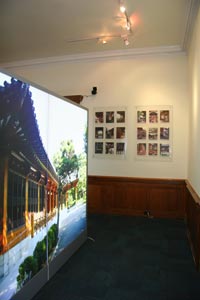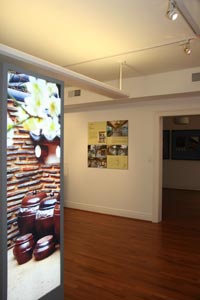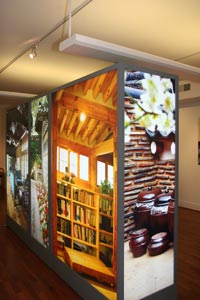
A Critical Look Before Moving Forward
by Agapé Tay
In the Autumn of 2008, the National Trust of Korea sponsored a series of exhibitions in the USA. Called "Stepping into Hanok for the New Millenium," the exhibitions were held in Los Angeles, Washington DC, and New York, and were based on an earlier, similar exhibition in Seoul designed to showcase the new buildings that had replaced traditional, "protected," hanoks that had been destroyed since 2001 during the implementation of the Bukchon Plan. Architectural correspondent Agapé Tay attended and reviewed the shows.
 |
In August 2008, President Lee Myung Bak announced the National Branding initiative on the 60th anniversary of the Republic of Korea’s establishment, and on January 22, 2009, the Presidential Council on the Nation Branding program was officially launched by council chairman Euh Yoon-dae, former President of Korea University.
At the core of their National Branding campaign, the South Korean government has recognized “hanok” as an important aspect of Korea’s cultural heritage.
“Hanok” are traditional Korean dwellings, which were developed during the Joseon dynasty (1392-1910). Constructed of a stone base, mud walls, wooden frame, paper doors and tiled roof, “hanok” consist of three distinct internal spaces: maru (wooden floor), ondol (heated floor), and bueok (the kitchen). These “hanok” were once ubiquitous structures that dotted the Seoul landscape.
The National Trust of Korea has been one of the main non-governmental organizations promoting the sustainability, preservation and appreciation of hanok in contemporary society. Inspired by the National Trust in the England, they were established in 2000, envisioning the environmental and historical preservation of Korea. Since 2000, the Bukchon area in Seoul, received massive funding from the Seoul Metropolitan Government as a preservation district for “hanok.”
In September 2008, the National Trust launched their First Overseas Hanok Exhibition “Stepping into Hanok for the New Millennium,” which toured from Los Angeles, New York, to Washington D.C. over a six week period. Based on an exhibition that they organized in Seoul the previous year, the National Trust featured fourteen “hanok” in the Bukchon area, including the U.S. Ambassadorial Residence Habib House, and the Yun Posun Residence, and a goodwill exchange “hanok” that was built in Paris, France.
According to the National Trust’s co-director, Yun Sangkoo, this exhibition aimed “to show factors that make hanok comfortable and wholesome, and how it can accommodate modern living in an urban setting” as a part of the “greater effort by the National Trust of Korea to preserve and promote hanok and to accumulate data for the “Hanok Bank,” a data base of facts about hanok.”
However, the selection of residences, curation, and supplementary articles at this exhibition question the intention behind this attempted “preservation” and “promotion” of hanok.
The exhibition resembles a posh and elegant showcase for contemporary “hanok” lifestyle as if a home living and design publication, not the National Trust of a nation with the serious and impending issue of National Branding, created it.
The exhibition was an arrangement of approximately five feet tall photo light boxes, featuring quality photographs of “hanok” exteriors taken from the inner courtyards or spacious lawns of these residences. This created the illusion of walking through the architectural space of a “hanok” filled landscape. Along with professional architectural models of select residences, the exhibition resulted in a rich visual experience.
 |
 |
 |
| Pictures from the Exhibition in Washington DC | ||
While these aspects of the exhibition were visually pleasant, they did very little to further knowledge about “hanok,” and explain why they should be promoted or preserved. It seems too shallow to justify the preservation and cultural importance of “hanok” with mere visual beauty, which was the emphasis of this exhibition.
Despite the credibility of the academics and architects who contributed their expertise for the exhibition, the National Trust failed to curate a cohesive exhibition where the knowledge of these contributors enrich the audience’s understanding and appreciation for “hanok” beyond its visual pleasure and cultural novelty. Furthermore, the academics and authorities on “hanok” fail to define “hanok” and fully explore the positive influence it has on a contemporary lifestyle.
Contributing writer, professor, and linguist, Dr. Werner Sasse from Hangyang University states “Hanok are the result of 2000 years of Koreans adapting to the climate, including the summer heat.” His singular insight as a “hanok” resident is not reflected in the actual curatorial statements presented at the exhibition, which were written by academic authorities on “hanok,” as well as residents, the Cultural Affairs Office of the U.S. Embassy in Seoul, and members of the National Trust. The result instead was a hodge podge of statements with subjects ranging from architectural spatial analysis, historical narration, whimsical philosophical contemplation, to one resident’s Swedish meatballs.
What is even more questionable than the choice of curatorial statements is the motive behind the selection of these fourteen “hanok.” The “hanok” in Paris is most certainly a perfect example of the desired cultural novelty and supposed international acclaim of “hanok.” However, what is most striking is that the Yun Posun residence is the only historical “hanok” featured, while there are other historically significant hanok in the Bukchon area, such as the Baek Inje residence, Kim Hyungtae residence, and the Lee Jung-gu residence. Also, residences such as the L Home featured in the exhibition has been “preserved,” now featuring huge panes of glass instead of clay walls, which Dr. Sasse describes as being protective and having the “function as an organ of communication between the body and soul of man inside, and nature outside…[and]…Like human skin they are an organ regulating temperature and moisture.” What has a residence like L Home retained from the original spirit and function of “hanok,” other than the most instantly visual bullet points of a tiled roof and wooden frame?
The First Overseas Hanok Exhibition of the National Trust of Korea was a true disappointment to those who sought to be enlightened on the “wholesome and comfortable” lifestyle that the uniquely Korean “hanok” has to offer. Is it just the visual illusion of escape from the urban city into nature that these residents enjoy? If a modern house were to embody the visual checkmarks of a traditional tile roof, mud wall, paper screen, wooden frame, and a courtyard area, would it be any different than the “hanok” exhibited? The exhibition was not prepared to address or to take these concerns into consideration.
With the new Presidential Council to review and reconstruct South Korea’s National Brand Image, it is important that council chairman Euh Yoon-dae consider these and other issues as priority when undertaking the task of determining the way “hanok” are re-appropriated as South Korea’s cultural heritage.
Agapé Tay
New York, December 2008
Exhibition Leaflet is here
Interested in living in a hanok?
You can see architectural plans and drawings of the original hanoks of Bukchon here
http://www.kahoidong.com
Contact
us
![]()